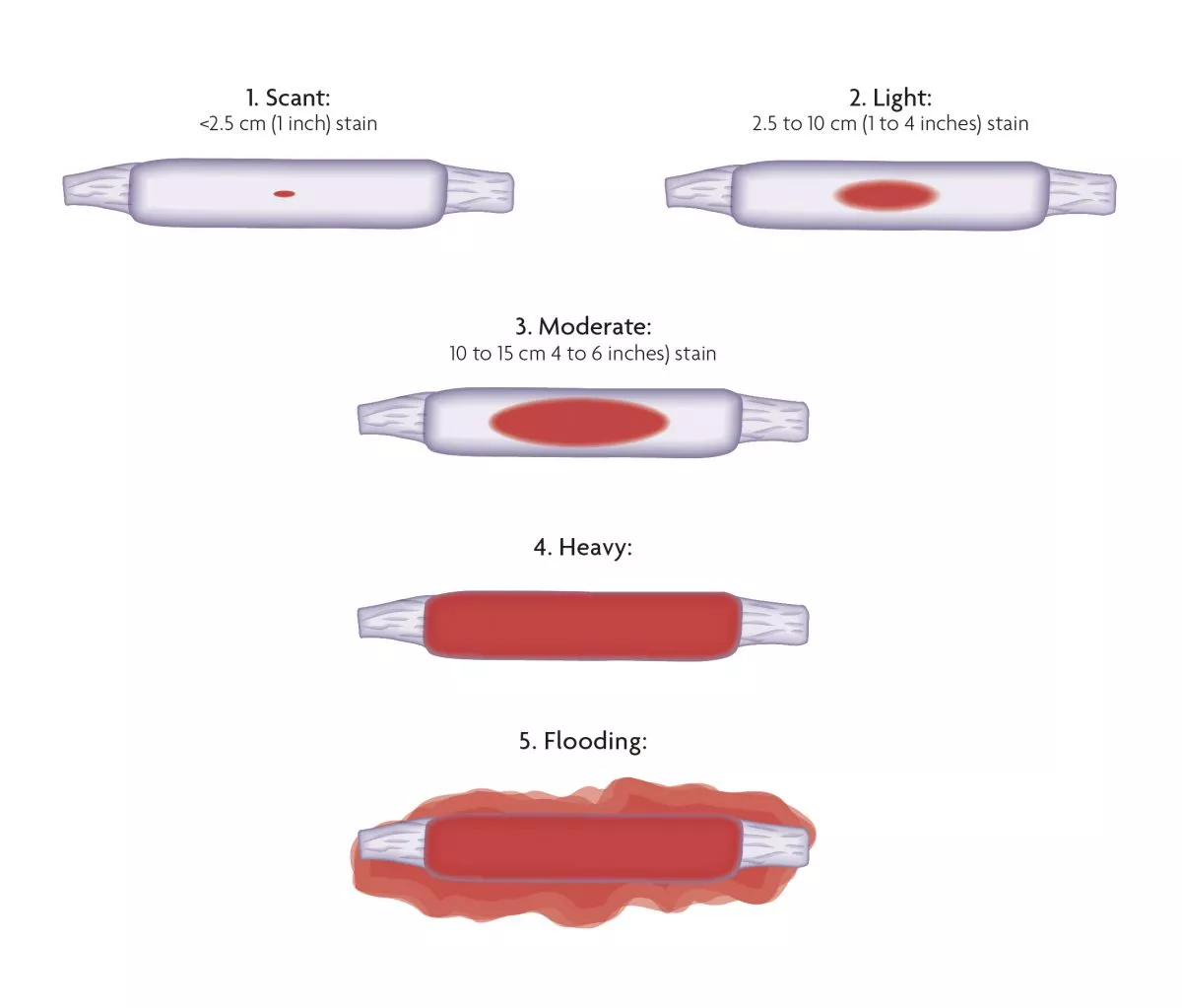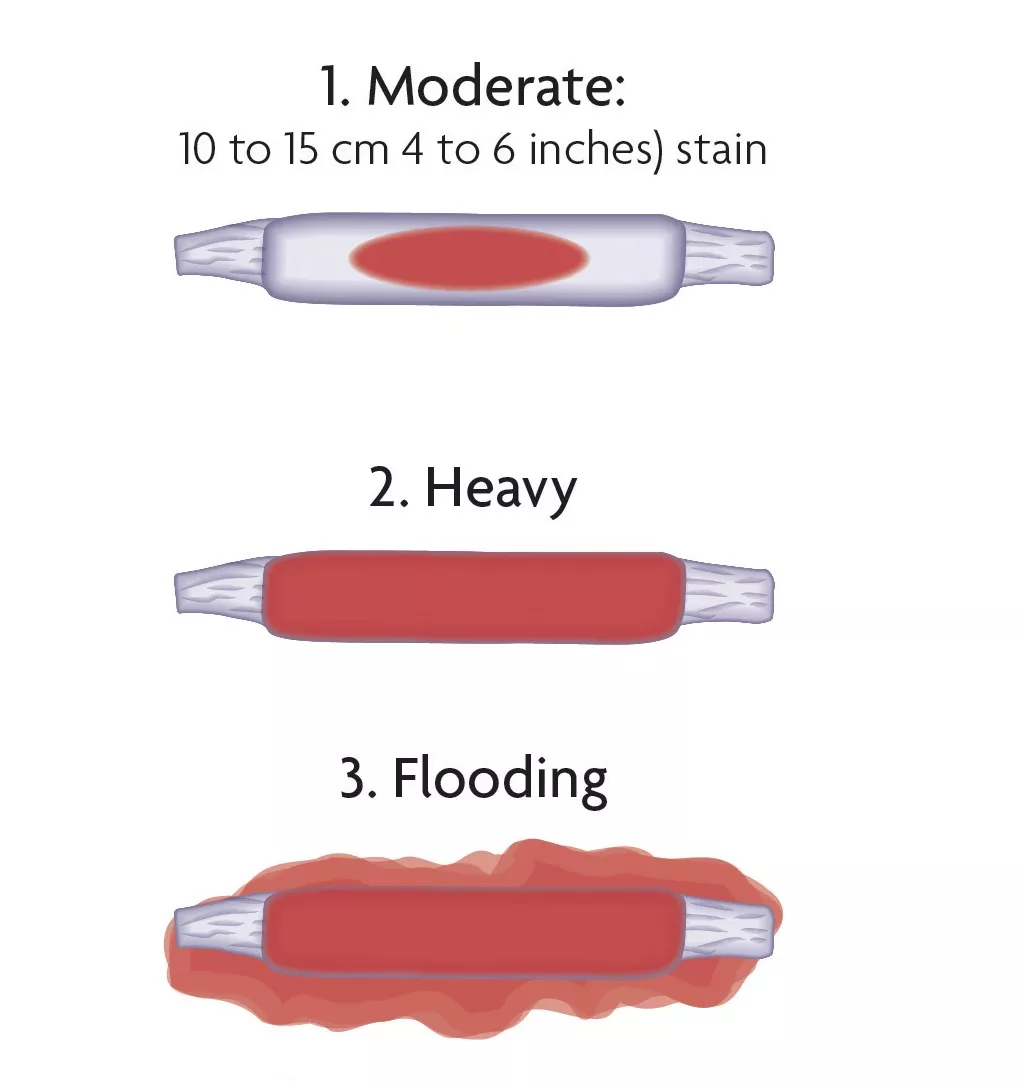Caring for yourself after your Abortion
Women typically bounce back fast after having an abortion. See the valuable details below to learn how much Pain and bleeding you might suffer later.
1. What to expect after treatment
1.1.1. Bleeding after Medical Abortion
1.1.2. Bleeding after Surgical Abortion
1.1.3. How much bleeding is too much?
1.2.1. Pain during and after Early Medical Abortion (abortion pill up to 10 weeks)
1.2.2. Pain after Surgical Abortion
2. Physical signs as your body recovers
4.2. Other activities, including work
5. Unexpected or unusual symptoms after an abortion
1. Aftercare: What to anticipate
1.1. Bleeding
Always use sanitary towels to check for and manage bleeding during and after early medical or Abortion pill therapy.
Abortion pill (Medical Abortion) bleeding up to 10 weeks of pregnancy
Each Abortion is unique in terms of the volume and kind of bleeding. While having a medical abortion, it is common to bleed (see figure below). During a medical abortion, some women may pass blood clots, but if they do, they should be no bigger than a lemon.
No bleeding, minor bleeding, or floods are NOT normal (see below figure); therefore, call your doctor if you notice any of these symptoms:
- By the 24th hour after taking Misoprostol, you should not be bleeding at all, be experiencing minor spotting, or observe blood only on a tissue (see 1. Scant).
- Over two hours, you soak two maxi-sized sanitary pads in the blood (see 4. Heavy).
- Get medical attention immediately if you feel uncomfortable or encounter severe bleeding (see 5. Flooding).

Typically, bleeding and cramps begin 2–4 hours after taking Misoprostol. However, this delay of up to a few days is possible.
There should be a noticeable decrease in bleeding after delivery. You may experience spotting up until your next period, which is typical for most women and lasts roughly two weeks. Some women have brief episodes of agony with a burst of blood or a clot many weeks after their Abortion; if this persists, please let us know.
1.1.2. Bleeding after Surgical Abortion
Expect to flow heavily, maybe passing little blood clots, as if you had a regular monthly period. Usually, bleeding ceases within 1-2 weeks. However, some women continue to spot it until their next period.
Several weeks after the Abortion, you may have a brief episode of discomfort accompanied by a gush of blood or a clot; if this persists, please let us know. However, some women don’t experience bleeding until their next period is due, which is also expected.
1.1.3. How much bleeding is too much?
If you soak more than two maximum-size sanitary towels every hour for more than two hours in a row, you should consult a doctor (see example 3 flooding below).

1.2. Pain
1.2.1. Pain during and after Early Medical Abortion (abortion pill up to 10 weeks)
Pain Caused by and Following an Early Medical Abortion (Abortion Pill up to 10 weeks)
The second drug, Misoprostol, may induce severe cramping and profuse bleeding as little as two hours after taking the pills. This often lasts for a few hours and peaks during the process of expelling the pregnancy. In most cases, the pregnancy will end between 2 and 4 hours later.
However, this window is flexible. You may be prescribed Codeine, but you may also get painkillers at local grocery stores and pharmacies. If you need assistance coping with your Pain, please read the “Pain management” section.
If the painkillers aren’t helping, you must contact your physician.
The discomfort should lessen substantially when the pregnancy is over. However, for the next week or so, you may have cramping, which may be relieved with Ibuprofen or Paracetamol.
1.2.2. Pain after Surgical Abortion
After a Surgical Abortion, most women endure cramping intermittently for approximately a week. Then, as may, take some over-the-counter pain relievers like Ibuprofen or Paracetamol; these pain relievers are available without a doctor’s prescription and may be purchased from any store, pharmacy, or supermarket.
Ibuprofen pills come in two strengths; while taking either, be sure to read and follow all dosage instructions provided. If the prescribed dosage of each medication is insufficient to alleviate your Pain, you may combine both.
1.3. Feelings
Most women feel relief after having an abortion, but others may experience sadness or regret. Despite your generally good physical health, you may sometimes find that your mental and emotional health is struggling.
If you want to get something off your chest but are worried that others are sick of hearing from you, consider the following. Trouble sleeping, low mood, replaying events in your head, and stressing that your spouse doesn’t get it are all signs of emotional distress. This is perfectly natural, and it might be helpful to speak it out with someone empathetic and nonjudgmental.
Make an appointment with your doctor for post-abortion therapy if you feel the need to discuss it.
2. Physical symptoms as your body recovers
Within 3 days after an abortion, most women no longer have morning sickness, vomiting, or fatigue. However, it might take 7-10 days for the Pain in your breasts to disappear.
After surgery, your breasts may be sore and hard, and you may also have some milk leakage. Wearing a supportive bra and applying ice packs to your breasts can help you feel more at ease. When pain medication is required, use Ibuprofen or Paracetamol.
3. Your next period after an Abortion
You will start your next period four to six weeks after finishing your therapy. A pregnancy test should be taken if you have not had your period 4 weeks after completing your medication.
If it returns positive, you should call the facility where you were seen to schedule a follow-up visit. Any bleeding you have right after your treatment is not your period and should not be treated as such.
4. What can I do?
4.1. Bathing after an Abortion
Just take a regular bath or shower. If you’ve had a general anesthetic, wait at least 24 hours before getting in the tub. If you still feel sleepy after that, you should be monitored by a responsible party.
4.2. Other activities, including work
Within two days, the vast majority of women will feel good enough to resume their regular routines. Resting up till you feel back to normal is our top recommendation.
4.3. Sex after an Abortion
You may resume sexual activity if you have fully recovered from the effects of the abortion. If you do not want to become pregnant, you should take contraception as soon as possible after an abortion.
4.4. Travel after an Abortion
If you can avoid it, try to avoid travel for at least 24 hours after finishing therapy. If you must go, research local emergency services and know how to contact them if anything goes wrong. If you take the Abortion Pill for up to 10 weeks and want to travel shortly after taking the second medicine (Misoprostol), you should know that you may have cramping and heavy bleeding throughout your trip.
After having an abortion under general anesthesia or sedation, you may fly.
Please let us know if you need to take a flight after surgery. Any kind of anesthetic or sedative should result in a 48-hour no-fly period for flights of four hours or longer.
To sum up, we suggest:
- To travel after obtaining general anesthesia or conscious sedation, the flight’s scheduled departure time must be more than 12 hours following the last dose of anesthetic or sedative.
- If you become sick, you need to be with an adult who knows how to get you assistance.
- Only if you are feeling well and free of the following conditions should you board your flight: symptoms such as dizziness, fainting, nausea, vomiting, excessive bleeding, and severe stomach discomfort
4.5. Unexpected or unusual symptoms after an abortion
Call an ambulance immediately if you notice any of the following symptoms within 24 hours after finishing your therapy:
- Loss of consciousness;
- Severe allergic reaction;
- A confused state;
- Concern for a heart attack or stroke;
- Chest pain;
- Slurred speech;
- Breathing difficulties;
- Fits that aren’t stopping.
In the event that you experience any of the following, please call your doctor immediately:
- Lasting pain;
- Discolored or smelly vaginal discharge;
- Abdominal tenderness;
- Fever;
- A general feeling of being unwell or still feeling pregnant;
- Continuous and heavy bleeding that soaks 2 or more maxi-size pads in an hour for 2 hours in a row;
- You performed a pregnancy test 3 weeks after your abortion pill treatment under 10 weeks, and the test was positive, invalid, or you were not sure of the result.
Constant, heavy bleeding that soaks two or more maxi pads an hour for two hours in a row; this may be accompanied by a general sense of illness or a continued pregnancy-like state
In the three weeks after your under-10-week abortion pill therapy, you took a pregnancy test and either got a positive result or weren’t sure whether you did or didn’t.

 Français
Français